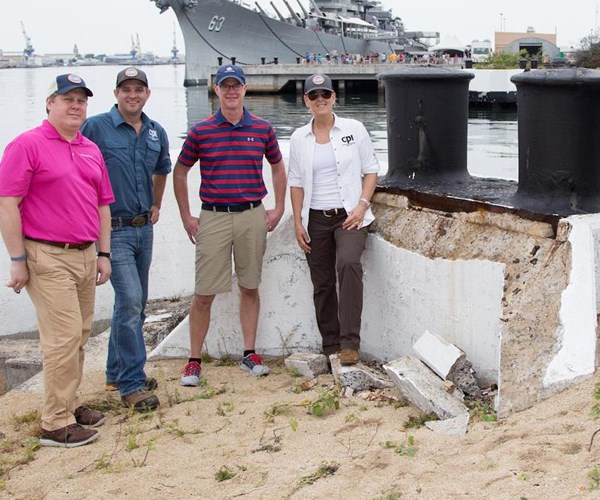Owens Corning donates fiberglass composites for restoration at Pearl Harbor
This program will restore the historic Battleship Row mooring quays, while helping U.S. Army personnel transition to civilian jobs.

Representatives from Owens Corning and Concrete Preservation Institute on a Battleship Row mooring quay at Pearl Harbor.
As this year marked the 75th anniversary of the Pearl Harbor attack, Owens Corning Composite Solutions Business (Toledo, Ohio) is donating money and materials to help restore historic Battleship Row mooring quays, while helping U.S. Army personnel transition to civilian jobs.
Owens Corning and the Concrete Preservation Institute (CPI, Chico, Calif.) announced an agreement through which Owens Corning and its Foundation will support CPI’s Career Skills Program at Pearl Harbor. Owens Corning Foundation will donate $100,000 to support CPI’s Career Skills Program at Pearl Harbor. In addition, Owens Corning will donate fiberglass composites to CPI for use in restoration work, where appropriate, in the Pearl Harbor Battleship Row mooring quays – used to secure the ships along Battleship Row and the last structures remaining from the attack on Dec. 7, 1941. Owens Corning volunteers will provide materials expertise to the project
“Launching the program this year, the 75th anniversary of the Pearl Harbor attack, highlights the importance of honoring the past while inspiring the future,” says Tanya Wattenburg Komas, founding director, president, and CEO of CPI. “With the generous support of Owens Corning, we are honored to help preserve this important national monument while contributing to meaningful veteran employment that addresses a national workforce development need for skilled trades and management in all areas of construction, including repair of infrastructure.”
CPI’s Career Skills Program is the first overseas program to be approved by the U.S. Army and the only one focused on concrete. Service members from any military branch can participate in the Pearl Harbor program at no cost due to program partnerships, donations, and grants. Active-duty service members will participate in CPI’s three yearly, 12-week sessions for the Battleship Row mooring quay restoration project. They will learn hands-on about concrete, construction and historic preservation while helping preserve one of the country’s most important historical sites.
“In our composites business, we’re committed to developing solutions to help reinforce our future, which involves both preserving national treasures and improving the integrity of future structures,” says Teresa May, vice president of strategic marketing for Composite Solutions Business, Owens Corning.
Owens Corning sponsored the graduation of the first cohort to complete CPI’s Career Skills Program at World War II Valor in the Pacific National Monument on December 5.
CPI will work with the National Park Service and other stakeholders to determine the proper preservation approach and then contribute its expertise in concrete repair and material systems. When appropriate, this may include the use of advanced reinforcing materials within the concrete system to ensure durability.
“CPI’s Career Skills Program gives us a great opportunity to help the men and women of our military transition to civilian life,” says Don Rettig, president of Owens Corning Foundation. “Starting this relationship and work with CPI on National Pearl Harbor Remembrance Day makes it especially meaningful to our employees.”
Related Content
-
Plant tour: Collins Aerospace, Riverside, Calif., U.S. and Almere, Netherlands
Composite Tier 1’s long history, acquisition of stamped parts pioneer Dutch Thermoplastic Components, advances roadmap for growth in thermoplastic composite parts.
-
MFFD longitudinal seams welded, world's largest CFRTP fuselage successfully completed
Fraunhofer IFAM and partners have completed left and right welds connecting the upper and lower fuselage halves and sent the 8×4-meter full-scale section to ZAL for integration with a cabin crown module and testing.
-
Cutting 100 pounds, certification time for the X-59 nose cone
Swift Engineering used HyperX software to remove 100 pounds from 38-foot graphite/epoxy cored nose cone for X-59 supersonic aircraft.
















